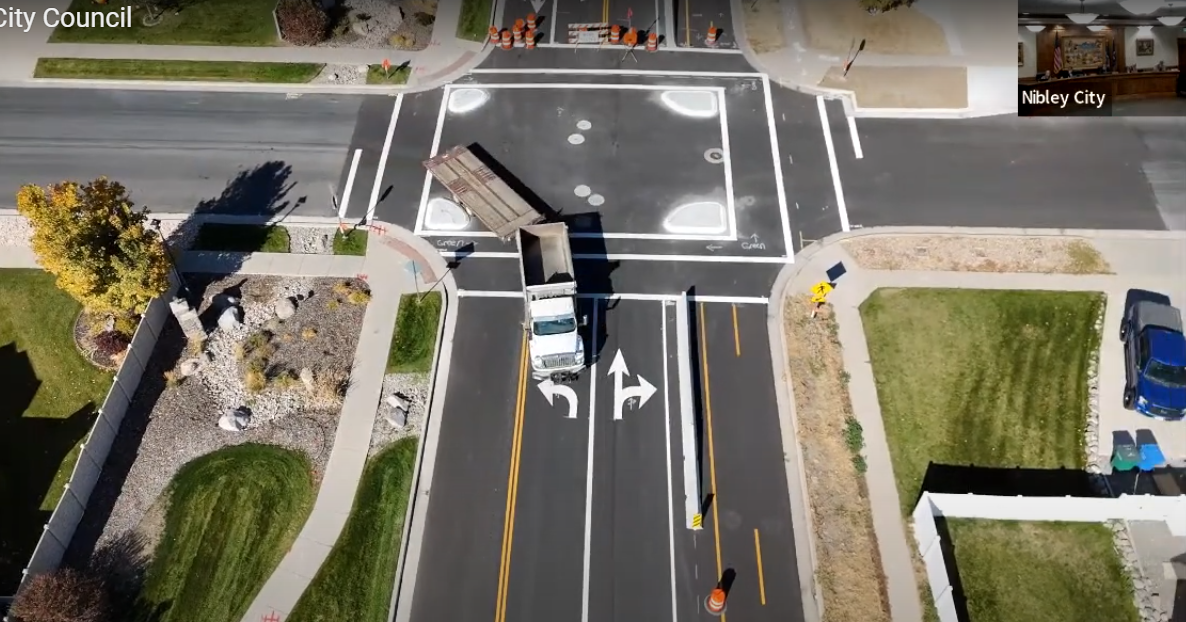NIBLEY – It has been a week since Nibley City opened a new section of road filled with mountable concrete islands and jersey barriers that are meant to slow traffic in the area – at the behest of hundreds of residents.
“We need to help people understand how to drive that intersection safely,” says Nibley City Mayor Larry Jacobson, noting it is different than most other transportation corridors in the valley, but feels with the proper education it will become a safer area for all to drive, bike or walk.
“We need to do the education and we are late getting it done,” Mayor Jacobson told Cache Valley Daily.

Nibley City Council Meeting video of intersection at 1200 West and 2980 S. in Nibley. (Courtesy: Nibley City YouTube)
He says the traffic-calming measures are working as planned, however, he recognizes the city has more “educational opportunities” ahead.
On Oct. 24 at a public meeting, the city council approved a resolution to keep the current setup for one year before readdressing. After a year, another re-evaluation will allow for additional public comment periods and educational opportunities. The council voted three in favor, two opposed to approving the passing of the resolution.
During that council meeting residents voiced their opposition to the design on the 35 mph road, which includes a number of speed-reducing safety measures including chicanes, (horizontal shifts in the road) a bicycle lane divided by a jersey barrier. The majority of public input was directed toward the mountable islands at three different intersections, specifically the one at the entrance of the Stonebridge subdivision located on 2980 South and 1200 West.
“It’s the ugliest, stupidest design I’ve seen,” said Nibley resident, Cameron Boehme, who mentioned just that night he saw kids using the barriers as jumps for their bikes. “There is no safety here – it’s stupidity.”
Others voiced concern that the street is over-engineered and too many safety measures have been put in one place.
Nibley resident, Garrison Sagers shared with the council that his son was struck and killed by a truck while biking on 1200 West in May of 2021.
“I don’t want that for anybody,” Sagers said. “Every time I pull up to that intersection, I want to feel like something has been done to prevent that. I don’t feel like what we’ve got does that.”
The primary goal of these measures, according to Nibley City Manager Justin Maughn, is to address a longstanding issue with speeding on local roads. Before the public comment period, Maughn explained that the city’s traffic master plan has a particular focus on reducing the high speeds observed on roads like 800 West, 1000 West, and 2600 South, where 75 percent of drivers were found to be exceeding the posted speed limit of 25 mph.
“We want to make sure that people are driving at speeds that are safe for everyone—pedestrians, cyclists, and other drivers,” Maughn said.
The Cache Metropolitan Planning Organization estimates 1200 West will have an average daily traffic of up to 7,000 motor vehicles by 2035 — which is almost twice what currently exists on 3200 South, the busiest section of road in Nibley currently.
Scott Shea, Phd with CRS Engineers, who has 15 years of traffic & safety engineering experience, designed the roadway and spoke at the meeting. He said the design is meant to narrow the roadway and force drivers to slow down, which is a part of a broader strategy to create a “self-enforcing” street environment.
“If it starts to feel uncomfortable, that is a visual cue you are going too fast,” Shea explained.
He said studies have shown that drivers tend to select speeds that feel comfortable to them, without recognizing the potential dangers to others. The mountable islands, while allowing larger vehicles to pass over them if necessary, are designed to force smaller vehicles to slow down by narrowing the roadway and providing a more confined driving space. This, in turn, reduces speeds and increases driver awareness of pedestrians.
“The paradox of street design is if it feels a bit dangerous … it is probably safer,” Shea said. “Because you have the limit of what you should be going.”
Despite the vocal opposition and two online petitions with more than 460 signatures requesting the removal of the barriers, the City Council voted 3-2 to approve a resolution keeping the current traffic measures in place for one year, allowing for a re-evaluation after further public feedback.
Councilmember Garrett Mansell expressed concern that waiting for a year would delay needed changes.
“I don’t feel like if we approve this tonight and wait a year, I don’t feel like we are doing justice to the residents,” Mansell said. “Especially those who live in Stonebridge, ‘cause this is their only option. We have no other option for them, coming in and out.”
Other council members suggested they were OK approving the resolution because residents may still reach out within the year to provide comment and the resolution allowed the city manager and council to make minor adjustments, if necessary.


